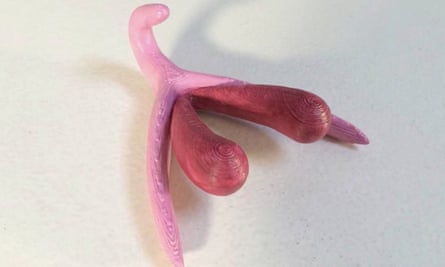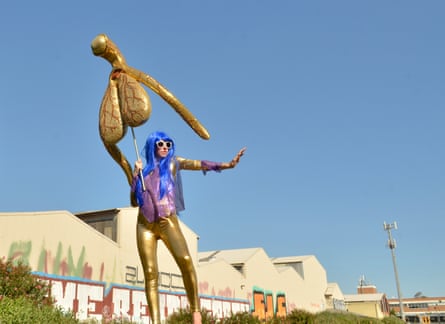
Professor Caroline de Costa is awaiting feedback. Several months ago the editor of the Australian and New Zealand Journal of Obstetrics and Gynaecology requested an editorial from a world-renowned Melbourne urologist to address what she saw as a lack of research and, more concerningly, a persistent lack of knowledge about an essential part of the female reproductive system.
The urologist, Professor Helen O’Connell, agreed. But a week after the editorial was published, De Costa’s inbox remains suspiciously silent. She suspects her colleagues, used though they are to dispassionate discussion of female genitalia, may be too embarrassed to write in.
The editorial was about the clitoris, an organ whose sole function is the female orgasm. And an alarming number of medical professionals remain uncomfortable discussing it.
“It is not discussed,” says De Costa, who is also a professor of obstetrics and gynaecology at James Cook University. “I go to conferences, I go to workshops, I edit the journal, I read other journals. I read papers all the time, and never do I find mention of the clitoris.”
The first comprehensive anatomical study of the clitoris was led by O’Connell and published in 1998. A subsequent study in 2005 examined it under MRI. It was not, O’Connell discovered, just a small nub of erectile tissue, described in some texts as the “poor homologue” of the penis. Instead it was an otherworldly shape, with the nerve-rich glans merely the external protrusion of an organ that extended beneath the pubic bone and wrapped around the vaginal opening, with bulbs that become engorged when aroused. It looked like an orchid. It was beautiful.
In the 20 years since that groundbreaking study was released, clitoral anatomy remains largely absent from the medical curriculum and from medical research. A literature review conducted by O’Connell’s team for her editorial in the Australian and New Zealand Journal of Obstetrics and Gynaecology found just 11 articles on anatomical dissection of the clitoris had been published worldwide since 1947. Hundreds more mentioned clitoral anatomy only as it related to procedures to restore sensation following a cliteradectomy, or female genital mutilation. Despite that work, O’Connell wrote, “we see literature doubting the importance of female orgasm, entertaining the argument that from an evolutionary standpoint, female orgasm could merely be a byproduct of selection on male orgasm”.
Speaking to Guardian Australia from her consulting rooms in East Melbourne, O’Connell says the view that the clitoris was at best unimportant and at worst shameful remained pervasive. She recalls a conversation at an awards night, in which one of her students won a prize for a study of the suspensory ligaments that hold the clitoris in place.
“The very senior figure directly across from me thought that her work was – and I was her supervisor, I don’t think he knew that – he thought it was voyeurism,” she says.
“She’s doing scientific research about anatomy, and that, in his world … ”
She pauses. “What happened to him, that he sees a young woman doing a project like that and thinks of it with a sexual innuendo? That is just, to me, unfathomably unrelated to the way my brain works.”
A rebellious doctorate
When O’Connell was a medical student in the 1980s she was infuriated by her anatomy textbooks, which contained extensive anatomical drawings of the penis and registered the clitoris as a footnote.
“There’s the norm that’s the male, and then we’ve got kind of this subset over here who are not male,” she says. “And their unique characteristics are differences … there was a feeling that they were not whole people in the way that these other people are whole people and deserving of having their body parts having a full description.”
When she specialised in urology, she noticed that while attention was paid in prostate removal surgery to not harming the nerves that connected to penile erectile tissue, based on studies that were first conducted in the 1970s, there had been no similar work tracking clitoral nerves. She undertook a study on 12 cadavers following the nerves from the spinal column. “It was pretty clear that what we were looking at was kind of a shadow of an organ rather than the organ itself,” she says.
O’Connell then enrolled in a doctorate to study clitoral anatomy.
“I think the chances of a male realising there was a deficit when most of my female colleagues didn’t see it would have to be incredibly unlikely,” she says. “I think I was raised a little bit rebelliously.”
She is now able to describe the shape of the clitoris with the help of a 3D printed model that was designed in conjunction with Dr Ea Mulligan, a doctor from Adelaide who has made the manufacture and distribution of thousands of anatomically correct clitorises a retirement hobby. Mulligan distributes them at conferences and public health seminars, and is planning to set up a stall distributing free clitorises at Feast, Adelaide’s queer arts and culture festival, in November.
When I speak to her on the phone at her home in Adelaide, she offers to send me one of the three boxes, with 200 clitorises apiece, that is currently sitting on her back porch. A box has been sent to O’Connell, a box to De Costa, and a box to the professor of anatomy at a medical school in Dunedin, New Zealand, who was previously working with a pathology sample of a clitoris that “looks like a shred off of last week’s roast”.
“A lot of medical students and doctors I have handed them to have said ‘Oh I didn’t know it was as big as that’, because it’s been diminished in the medical literature,” Mulligan says. “It’s just a beautiful case study on the invisibility of women’s concerns in science, in medicine.”
When Mulligan studied medicine in the 1970s, she was working from an anatomy textbook that had one page on vulvar anatomy and “five pages of penises from every possible angle”.
It is only marginally better now. James Cook university, where de Costa teaches, holds a one-hour lecture in fifth year about the role of clitoris in sexual function. The curriculum to be a fellow of the Royal Australian and New Zealand College of Obstetricians and Gynaecologists covers sexual function and related disorders, but not specifically the function of the clitoris. The college said it encourages “self-directed learning” and “acknowledges a long history of poor understanding of female anatomy and female sexuality”.
“RANZCOG supports all efforts to improve knowledge of genitourinary anatomy, physiology, and pathophysiology, with the aim of best practice in women’s health,” the college said in a statement.

The cliterati
Back in her consulting rooms, O’Connell appears remarkably fresh for someone who was in a mortuary until 1am the night before. She was conducting a dissection to map the anatomy of the urethra as part of a global effort to combat female urethral cancer, she tells Guardian Australia.
With her neat glasses and dry, technical language, O’Connell does not appear the rebel. But then she talks, quite calmly, about subjects that would make many of her peers blush, and the rebel slips out.
Take orgasms. In 2016, O’Connell co-authored a paper that found, based on a series of macroscopic anatomical dissections, that there was no evidence of erectile tissue in the vaginal wall – in other words, that the G-spot did not exist. (O’Connell has stressed there was more work to be done on the subject, including mapping the urethra.) To date, the only known erectile tissue in the area is the clitoris, leading to the working theory that the G-spot is just the engorged bulbs of an aroused clitoris felt through the vaginal wall.
Importantly, that meant that the clitoris would have to be stimulated for that sensation to be felt. This is not a new fact to people with vaginas, but distributing it is an important part of ensuring they have healthy, satisfying sex lives.
That the majority of women and people with vaginas require clitoral stimulation to orgasm is “just a statement of fact”, O’Connell says. “Ignoring the clitoris and acting like that’s not the focus for orgasm is just not going to happen.”
She speculates – after specifying that she is not speaking as a urologist – that centuries of sexism, fed by unrealistic depictions of sex in Hollywood, have helped build the G-spot myth and minimise the role of the clitoris. And that encourages people to “go about things in a way that is likely to be counterproductive”.
“People want kind of a magical thing, where he gets off through penetration of the vagina and exactly what causes his joy causes her joy,” she says. “Almost everyone is going to fall short on the goal because the organs just don’t seem to be designed in this magical way that would fit with the kind of thrusting behaviour causing an orgasm.”
Outside of medical circles, O’Connell’s research has been enthusiastically embraced. US-based artist Sophia Wallace created a campaign on “cliteracy”, informing women about their own anatomy.
Wallace’s art brings an organ with a dark history into the light, O’Connell says, adding: “It’s cool, isn’t it?” She is unabashedly delighted by unintentionally sparking a feminist art movement. “It’s fantastic!” she says. “Who would ever have imagined something like that happening?”
Artists, says De Costa, have “undeniably” done a better job at incorporating clitorial anatomy into their work than the Royal Australian and New Zealand College of Obstetricians and Gynaecologists.

Alli Sebastian Wolf, a Sydney based artist, created 100-1 scale anatomically correct gold clitoris, called the Glitoris, in 2017.
“I was in my mid-20s when I saw what a clitoris actually looked like and was kind of, first of all amazed by how wonderful it is, and second of all: how the fuck have we not been shown this or taught this? When I knew well before puberty what a fallopian tube and uterus shape was. Which, you know, far less important to my daily life,” she says.
The Glitoris can be hung in a gallery but achieved viral fame when Sebastian Wolf took it to the Women’s March, Mardi Gras and other public events, accompanied by the Cliterati – Sebastian Wolf and friends in gold unitards and blue wigs.
“A lot of people just thought it was a golden-y squid creature, a lot of people thought it was lungs, or a dragonfly, or testicles,” she says. “I met a couple of OB-GYNs who hadn’t known about it until the sculpture, which is horrifying.”
Sebastian Wolf says it can be easier for some people to talk about sex and sexual organs at a festival to a woman covered in glitter, than to their doctor. She is currently working on a one-storey high inflatable gold clitoris, but says she hopes knowledge of the clitoris will soon become so uncontroversial that making art about them would be as passé as making art about penises.
“It will hopefully get to the point where my art is totally irrelevant,” she says. “It would be great if the most interesting thing about it is if people were like ‘Oh, how did you get all those sequins on?’ Not, ‘What’s this and why don’t we know about it?’”
O’Connell’s aim is similarly modest: that female anatomy be considered equally alongside male anatomy. And that necessarily means overcoming an institutional and societal prejudice against women enjoying their own sexuality. It means studying the clitoris.
from Lifestyle | The Guardian https://ift.tt/35XQ2aC
via IFTTT

comment 0 Comment
more_vert